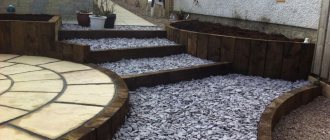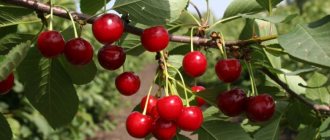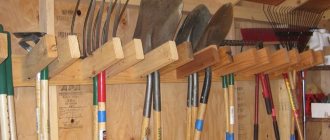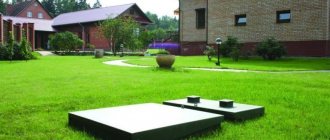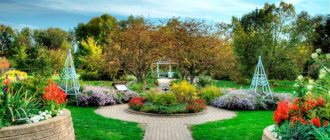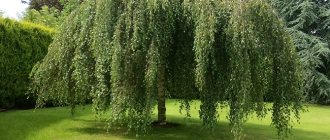Not everyone has room in their yard for a giant ship pine or huge oak tree. But fortunately, there are many dwarf trees suitable for small gardens. Such trees usually grow no more than 4-4.5 meters in height. Not only do they fit easily into landscape designs, but they are also less labor-intensive to maintain than large trees. In this article I would like to talk about my favorite short trees that are worth paying attention to when landscaping a small garden.
Popular short trees for landscape design
Advantages of short trees
Although dwarf trees are small in size, they can still make a big contribution to the landscape. We love dwarf breeds for their miniature size, unique shapes and, of course, the color of their foliage or flowers. When choosing trees for small gardens, it is essential to find out the maximum height of the tree and how long it will take for it to reach that height. Some species grow slowly and initially fit very well into a small garden. But over time, they can grow too large and take up all the available space, blocking light and potentially damaging the foundation of your home.
Fortunately, there are many species and cultivars of trees that are compact in size and remain compact throughout their lives. A correctly selected and well-placed tree will become an attractive center of attention and will arouse interest throughout the year. Pruning is usually an easier task in this case.
If you have a small yard, focus your attention on vertical space. That is, choose plants that grow upright and have a narrow crown to make the most of the available space.
In addition to decorative foliage plants that will brighten the garden all season long, or beautiful flowering plants that produce a wave of blooms in spring or early summer, look for trees with berries to attract birds and provide them with nesting sites.
If you don't know where to place your tree, growing it in a pot may be a solution. In this case, you can place it in different places and take it with you if you move. This growing method is also useful if you need to protect a heat-loving tree in winter by moving it to a frost-free room.
How to care for a fruit “mini garden”
The basic rules of care include systematic loosening of the soil, removal of weeds and other vegetation. To avoid the appearance of crusts on the ground, you will need to mulch the soil. Compost is used for such purposes.
Particular attention is paid to the soil during the dry season. To retain moisture, the soil is covered with hay. Mulching is carried out so that the layer is not located too close to the trunk. It is not recommended to apply mulch during wet periods.
Watering
It is recommended to water the mini garden weekly. 2 buckets of water should be added to 1 seedling.
Fertilizers
It is best to fertilize after the soil is moistened. For dwarf plantings, fertilizing with mullein or chicken manure is ideal. It is recommended to dilute mullein with water in a ratio of 1 to 10, and chicken droppings - 1 to 20.
Diseases
Most often, gardeners encounter powdery mildew, mosaic and cytosporosis. The first disease manifests itself in the form of a white powdery coating. This is a fungal disease that progresses quite quickly. Fruits on such trees may not bear fruit and may become deformed. As preventive methods, it is recommended to carry out systematic pruning, remove debris and fallen fruits. Thickening of the crown is not allowed. In spring, it is recommended to spray with Bordeaux mixture. If the plant is damaged, it is recommended to remove all damaged parts and burn them. It is also recommended to use the preparations “Tiovit Jet”, “Topaz”, “Quadris” for treatment.
Mosaic appears as green or white spots on leaves and fruits. This is a disease of viral origin. Leaves may become deformed and development may slow down. Often the disease occurs due to treatment with instruments that are not disinfected. Minor damage can be treated with Karbofos.
Cytosporosis is manifested by brown shades of the crown, the appearance of bumps and roughness. Treatment will only help in the early stages. All damaged areas are removed and burned. Then the trees are treated with Bordeaux mixture, also fed with ash and whitened with lime.
Properly selected dwarf trees for the garden will harmoniously complement a small area, fill it with beauty and provide fruit.
Ash maple "Flamingo"
Flamingo ' is a delightful little tree. Its young leaves turn bright pink in spring before turning green with a bright pink edge, which subsequently fades to creamy white, retaining a very light pink tint.
Unlike the common ash-leaved (American) maple in urban landscaping, this variety is not very winter-hardy and never grows tall. In the middle zone, it is usually grown as a coppice crop, that is, having frosted over this small tree (up to 5 m tall), it is restored from the root in the spring, remaining the size of a bush (2-2.5 m).
The lighter, brightly colored maple foliage contrasts well with darker coniferous or deciduous plants and flowers. Suitable for all soil types as long as good drainage is provided. Can be grown in full sun or partial shade. Trimming improves foliage color.
Acer negundo 'Flamingo'. © hopesgrovenurseries
Shrubs that do not require cutting
Snowberry
A honeysuckle shrub with bluish-green leaves that contrast with the large pinkish flowers. The crop does not grow more than 130 centimeters and is not suitable for decorating the area with figured plantings, since the shoots are difficult to tolerate cutting. But it is recommended to remove faded flowers for further formation of buds.
Dogwood
A feature of the shrub is the seasonal change in leaf color. In spring and summer, the foliage is green, and starting in autumn, the color changes to yellow, and later to deep purple. The shrub will grow quietly in the shade, in any type of soil, but for abundant growth it is recommended to fertilize the soil when planting. To plant a hedge, you should not take an adult plant (up to 3 years old). The plant grows up to 30 centimeters per year.
Clematis (Clematis)
See description above.
Boxwood
This small and compact shrub attracts designers and gardeners with its unusual leaf shape, reminiscent of four-leaf clovers, and its ease of care. The plant will not require special choice of location or soil, but will prefer infrequent watering during dry periods. As the shrub grows, it creates a dense, but not high hedge (in the first 5 years it adds 10-20 centimeters in height), which independently acquires the correct geometric shape, requiring almost no pruning or trimming.
Faulkner Boxwood, Buxus 'Faulkner', at Visalia CA USA Faulkner Boxwood, Buxus 'Faulkner', at Visalia CA USA
Kalmiya
This shrub will be loved by many for its lack of need for cutting and caring for shoots. It is recommended to plant the crop in partial shade, without direct sunlight and without stagnant water in the soil. The plant blooms profusely - the color and timing of flowering directly depends on the variety and care. It is important to plant young seedlings at a sufficient distance from each other (50-60 centimeters), since the shoots grow quickly and interfere with the normal growth of neighboring bushes.
Decorative apple trees
Add dramatic seasonal color to your landscape with ornamental apple trees (Malus). This group includes plants with purple foliage, carved leaves, but their main decoration is flowers in various shades of white, pink and red, and in the fall they bear orange, gold, red or burgundy fruits. One of the most popular varieties of ornamental apple tree "Royalty" with dark pink flowers, reddish-purple foliage and high disease resistance.
Decorative apple trees have a weeping, round or columnar crown shape. The height of such apple trees can vary, but usually does not exceed 4 m. Growing conditions are open sun, average humidity, well-drained soil. In some varieties of ornamental apple trees, the fruits may be edible, but they are often tasteless or even cause symptoms of poisoning, which must always be taken into account.
Ornamental apple tree (Malus), variety “Royalty”. © Sylvi
Spreading bushes and trees
A variety of varieties of lilac, Japanese quince, inimitable, widely climbing wisteria vine, heather - lushly blooming, tall and spreading specimens, which provide additional impulses for imagination
But creating a picturesque background is just as important as focusing on small details.
Important! When selecting plants for a site, it is necessary to take into account the individual characteristics of trees and shrubs, so that those growing next to each other have similar care requirements. Applying garden planting schemes to decorate spaces, buildings and structures is quite a challenging task. The difficulty lies not only in choosing a place for planting, but also in selecting the same type of care requirements.
Some plants prefer sandy soil, while for others it is absolutely contraindicated; there are those who like acidic soils, and some will simply die in such conditions. Turning to ready-made solutions is not always profitable, and in the end you may end up with something completely different from what was intended.
The difficulty lies not only in choosing a place for planting, but also in selecting the same type of care requirements. Some plants prefer sandy soil, while for others it is absolutely contraindicated; there are those who like acidic soils, and some will simply die in such conditions. Turning to ready-made solutions is not always profitable, and in the end you may end up with something completely different from what was intended.
Applying garden planting schemes to decorate spaces, buildings and structures is quite a challenging task. The difficulty lies not only in choosing a place for planting, but also in selecting the same type of care requirements. Some plants prefer sandy soil, while for others it is absolutely contraindicated; there are those who like acidic soils, and some will simply die in such conditions. Turning to ready-made solutions is not always profitable, and in the end you may end up with something completely different from what you intended.
Design from bushes and trees
In this article, options for designing a garden or summer cottage were proposed, and examples of planting and caring for certain types of plants were given. The proposed options are not considered the only correct ones, they are just a way to push you on the right path to choosing the garden of your dreams.
Iva "Hakuro Nishiki"
Hakuro Nishiki is the ideal plant to liven up dull spaces and give them an attractive appearance. The rounded silhouette of this miniature tree makes it an excellent accent plant. A problem-free large bush or small tree (up to 3 m tall), which grows quickly and will become a real highlight of the landscape. It stands out for its bright, color-changing leaves, thanks to which the bush may appear pink from a distance.
The young leaves of this willow are pink in spring, after which they turn white and green, and by autumn they turn yellow. One of the best qualities of this shrub, besides its color, is the soothing sound the leaves make when the wind blows over them.
The Hakuro-Nishiki willow is considered a low-maintenance shrub and can be easily grown in fertile soils that are well drained but constantly moist. Although it tolerates drier soils compared to other willows, it still requires regular moisture. This willow lends itself well to pruning. You can also often see it on sale in the form of a grafted tree on a trunk.
The only problem that can arise with such a willow is partial freezing of the branches in a harsh winter, however, the tree quickly recovers.
Willow whole leaf "Hakuro Nishiki" (Salix Integra Hakuro Nishiki)
Read also our article Variegated willows in my garden are beautiful at any time of the year.
Sequence of planting in open ground
- soil preparation, namely: digging, removing litter and stones, applying fertilizers;
- preparation of planting holes;
- planting seedlings.
The distance between the bushes depends on the size of the adult plant. Bulbous and rhizomatous plants can be used to fill unused space. If you plant the bushes too close, they will later interfere with each other.
Seedlings are planted near outbuildings or fences. When planting a bush in a flowerbed, it can be placed both in the back row and in the central part. Moreover, each of these options has its own advantages. A real highlight of any garden can be an ensemble of garden shrubs of various heights.
Alder buckthorn "Fastigiata"
Alder buckthorn "Fastigiata" (Frangula alnus 'Fastigiata', Ron Williams) is an original compact tree with a columnar crown, which from a distance can resemble a cypress. This is a persistent, hardy plant that does not require special care. The slow-growing tree is often grown as an addition to Japanese gardens or as the centerpiece of small arrangements. In adulthood it reaches a height of about 2.5 m.
The leaves are narrow, light green in summer and bright yellow in autumn. The bark is interesting for its bright color, so the tree is beautiful even after the leaves have fallen. Can grow in full sun, but develops better in partial shade. The breed is so frost-resistant that it can easily be grown in open ground or in containers (frost-resistant down to -40 °C). Almost any soil is suitable for buckthorn, except swampy ones.
Alder buckthorn "Fastigiata" (Frangula alnus 'Fastigiata', Ron Williams). © springmeadownursery
Principles of arrangement of trees in the garden, their combination with other plants
When planning a garden, the following categories are used:
- standard - usually medium or low, with a crown close to a ball in shape;
- various deciduous weeping species;
- dwarf fruit, deciduous trees;
- columnar hybrids.
Trees are arranged in one or two rows, singly, according to a certain pattern, in groups of an odd number of representatives of the same, different species. You can form so-called bosquets - mini-groves, which, with the help of haircuts, are formed into dense “living fences”, using both coniferous and deciduous species.
In the presence of large free spaces, some trees are used as tapeworms - light-loving plants planted in an open area. Often they use it to split the trunk so that the tree is as branched, spreading, and low-slung as possible. In some cases, gardeners, using special techniques, form spherical, conical, umbrella, pyramidal, and weeping crowns. Less often, several identical plants are planted close to each other, gradually they almost grow together, and from a distance they look like one.
It is also important to correctly combine elements of green spaces with each other - not all plants are friends. For example, jasmine, lilac, fir, horse chestnut have a detrimental effect on the development of pear and apple trees, and it is better not to plant anything next to mulberry or sea buckthorn
Most fruit crops do not tolerate proximity to birch, maple, and many conifers. Pines, spruce, and fir strongly acidify the soil, which is unacceptable for stone fruit and pome-bearing species. If there is oak, willow, or poplar in the garden, their fallen leaves should be removed before they begin to decompose. Certain tree species contain phytotoxins that are released into the air - while harmless to people, they seriously harm other vegetation.
Rowan
Most mountain ash (Sorbus) have beautiful feathery leaves, snow-white spring inflorescences and bright autumn berries. These are excellent trees for attracting garden birds such as robins and blackbirds. They like rowan berries, which are rich in nutrients.
An excellent choice for a small garden would be sweet-fruited varieties of rowan, which do not grow large and have a very original appearance. For example, the rowan "Pomegranate" with very large burgundy-red edible fruits does not exceed 4 m. Or the rowan "Titan" with sweet and sour cherry-red berries, 3 m high. The variety "Pendula" is a real sculpture in the garden, so how this weeping rowan forms strange shapes on a trunk and does not grow tall.
I also advise you to pay attention to the Kene rowan or its relative Kashmir , which amaze the imagination with snow-white or slightly pinkish fruits. The foliage of this rowan tree is more delicate and bright red in autumn. Often found grafted onto a standard. The height of the tree is 3-4 m.
Rowan (Sorbus aucuparia), variety "Pendula". © Floraplanet Rowan (Sorbus), variety “Titan”. © praskac
Rowan Koehneana (Sorbus koehneana). © Oregon State University
The best winter-hardy plum varieties
Among the winter-hardy varieties of plums, the following stand out:
“Stranger” - its yield is about 9 kg per tree. This plum is distinguished by the height and massiveness of its crown. The fruits are small and full of typical sweet and sour taste.
"Baikal plum" - adapted for growing in Siberia and its regions. It has such qualities as high tolerance to cold. Not susceptible to pest attack. Does not like excessive watering. A full harvest is about 7 kg in the second year after planting the seedling. Large fruits are characterized by juiciness and sweetness.
"Buryat Jubilee" - low trees with spreading branches. Tolerates Siberian frosts well. In the first ten days of autumn, sweet and sour fruits weighing 16 grams ripen.
“Vaulinskaya” is especially resistant to low temperatures. This is a shrub with spreading branches. Medium ripening variety with low yield. The fruits are sweet with a slight bitterness.
Hazel
Fruit varieties of hazel or hazelnut ( Corylus avellana
), which are grown mainly for their nuts, are also usually small trees 3-4.5 m and are well suited for small gardens, although it must be borne in mind that they usually have a fairly wide crown.
Decorative varieties of hazel grow more slowly and are more compact; in addition, they usually have a very original appearance. For example, hazel "Contorta" with twisted branches and deformed green leaves. Or "Red Majestic" hazel, which also has twisted branches and clenched leaves that are bright red. Both trees do not exceed 3 m.
The Pendula hazel has a very unusual appearance of an umbrella or hut with a weeping crown, which has a height of 2 m and a width of 2.5 m. The decorative hazel Aurea , 3 m high, which can become a good partner for numerous red-leaved varieties hazelnuts
Hazel prefers fertile, moisture-absorbing soils and does not grow well in dry conditions. The place should be sunny or slightly shady.
Hazel or hazelnut (Corylus avellana), variety "Red Majestic". © The National Gardening Association
Fruiting bushes
Rose hip
A fast-growing and flowering hedge shrub that can take root and grow in any conditions. Rose hips appear after flowering (May-June) on seedlings older than two years. Reaches 2 meters in height. Prefers moist soils and well-lit areas.
Blackberry
Another fruit-bearing shrub, which is famous for its fragrant flowering and tasty berries. It has a flexible shoot that can take on different shapes when attached to stabilizing sticks or stronger shoots. It is quite frost-resistant, but even if part of the bush freezes out, it quickly recovers. It is recommended to cover young seedlings for the winter.
Hawthorn
This shrub is absolutely unpretentious and does not require specialized care. It is capable of growing abundantly, creating impenetrable hedges, but it begins to bear fruit only after 10 years of life. Hawthorn loves sunny places and blooms and bears fruit better in direct sunlight. Red leaves undergo defoliation after the first frost, usually in mid-September.
Blood red currant
Despite its decorative appearance, which always attracts gardeners and designers, the shrub bears fruit with healthy berries, which are often used when preparing for the winter. This unusual shrub grows up to 4 m in height. The plant is not recommended in regions where the temperature drops below 23 degrees in winter or covering the seedlings.
reichblühend, dunkelrote Blütentrauben, wunderschön mit anderen Blütenstrüchern
Dwarf conifers
Conifers can make excellent dwarf ornamental trees. They can be easily trimmed and trained to remain short throughout their lives. Small specimens can be found in almost all popular coniferous tree species.
For example, thujas with a columnar crown for small areas: “Yellow Ribbon” (4 m), “Sunkist” (3 m), “Rheingold” (2-3 m), “Malogna Holub” (1 m), “Holmstrup” ( 3 m), "Green Egg" (2 m).
Beautiful examples
An expressive example of a flowering ornamental shrub is shown in the photo. Flowers raised to different heights look very original. But the main advantages of this composition are associated with the stems of the crops included in it.
And here the design effect was used using a thick pink carpet. With its help, you can transform a nondescript gray wooden fence and add elegance to it.
A composition of flowering shrubs can look extremely original. Here is a lush, squat carpet of white flowers. On the left is just a green mass, and in the middle is a neutral gray stone. This winding path serves as a good visual divider.
For more information on caring for and growing ornamental shrubs, see below.
Louisiana three-lobed
Louisiana three-lobed, or almond, or three-lobed plum (Prunus triloba) is a stunning analogue of sakura for the middle zone. It is a small dense, round, multi-stemmed tree 2-3 m high (but if necessary, it can be easily maintained at half this height by trimming).
At the end of April-May the tree becomes unusually beautiful. Pink double or semi-double flowers with a diameter of up to 4 cm bloom on it, which densely adhere to the entire upper part of the crown, as if glued to the branches. The tree also has an autumn yellow-bronze color.
Louisiana's leaves, elongated oval in shape with finely toothed edges, provide light shade during the summer months for perennials growing under its canopy. The tree will withstand the harshest winters and is resistant to most pests and diseases.
An avenue of blooming almond trees will create an impressive border along a walkway, patio or lawn, and the tree will look great in a garden pot.
Triloba plum is best grown in moist, fertile, well-drained loam in full sun or partial shade (blooms best in full sun). Monnilia can sometimes become a problem, but hybrids with plum species are not severely affected by this disease.
Louisiana triloba, or almond, or triloba plum (Prunus triloba)
Dear readers! If you're looking for a small tree for a small garden, also consider shrubs. Many tolerate pruning well and can be raised to give the appearance of a small tree. But at the same time, they will be lower than many trees, reaching a height of 3-3.5 m. Try this, for example, with viburnum, lilac, dogwood, bladderwort, paniculata hydrangea or elderberry.
Evergreen shrubs
Aucuba
This “golden tree” remains green in any frost and pleases the eye with glossy leaves covered with golden specks. Young seedlings need to be planted at a sufficient distance from each other (from 20 centimeters). The height of the crop reaches from 2 to 4 meters, and for active growth, it needs regular feeding in spring and autumn (at least 5 times a year). In the summer, the bush blooms with discreet but attractive flowers, which in the fall give way to berries.
Photinia
An original shrub that can be planted as a single small tree or created with the help of several seedlings as a hedge. The dark green leaves change color to a rich burgundy color in the fall. Flowering occurs in May-June, during which barely noticeable white flowers, collected in large inflorescences, are replaced by fruits. Easily tolerates temperatures down to -20 degrees and prefers sunny places in important fertile soil.
Holly holly
A fairly tall plant - up to three meters. Large snow-white flowers in autumn are replaced by bright red berries, which completely cover the tree or shrub. The glossy leaves contrast beautifully with the red berries, which is why the plant often becomes a decoration for homes at Christmas; the branches are used to make wreaths and bouquets.
Lavrovishnya
This evergreen shrub is of high value to landscape designers when creating decorative compositions. The plant takes root well in shaded areas with plenty of moisture and, with regular fertilization, pleases with abundant and persistent flowering. The shrub propagates very easily - by cuttings or seeds; it is recommended to plant it in the autumn, a few weeks before serious frosts.
Thuja
Thuja has a variety of varieties, which can be boasted by a small number of plants - about 100 species, but gardeners recommend the Smaragd and Brabant varieties for planting as a hedge. Although the culture belongs to conifers, instead of needles it has soft, pleasant scales that delight with a soft green color all season long. It is important to fertilize the young seedling and choose a sunny place for planting, otherwise the plant will lose its brightness and take a long time to gain growth.
Rhododendron ponticus
Tall, up to 5 meters, shrub with glossy, rich leaves, which in May are complemented by large purple-pink inflorescences. The plant loves fresh and nutritious soil with good drainage properties. It looks quite massive, so it is planted as a hedge, fence or decoration of a house line.
Mahonia holly
Fancy carved leaves attract attention, and golden flowers fill the garden with a lasting vanilla aroma. The shrub grows small - up to one and a half meters. This leafy shrub is one of the few that take root and overwinter in central Russia. Small yellow flowers are collected in fluffy inflorescences and abundantly decorate a small bush in spring.
Dracaena
Tropical dracaena is called the dragon tree: “dracaena” means dragon in Latin. An adult plant looks like a palm tree. The leafless stem ends in a tuft of long leaves bent downwards. Dracaena belongs to the asparagus family. In nature there are up to 40 plant species. The following varieties are common in home floriculture:
- fragrant;
- bordered;
- Derema;
- Sandera;
- godsefa;
- bent.
Dracaena is extremely popular among gardeners. At home, with proper care, it lives 12-15 years. Looking after her is not much of a hassle. A newly purchased dracaena needs to be transplanted from a cramped pot. As the root system grows, replanting must be repeated.
Dracaena loves diffused sunlight, like in the tropics. It should be placed near a south window, shaded by light curtains. The southern beauty cannot stand cold and drafts. In unfavorable conditions, the leaves begin to turn yellow and fall off.
Privet
Privet is a family of plants that combines two types of shrubs:
evergreen;
- deciduous.
Privet is distinguished by its fruit, presented in the form of a drupe, visually reminiscent of a berry. The plant is not afraid of frost, drought, or heavy rains. It can grow even where the soil has a high lime content. What can we say, if privet is often found on saline soils, which are destructive for most plants.
Privet is ideal for creating composite hedges. The shrub is easy to trim and allows you to turn an ordinary and unremarkable crown into a masterpiece of landscape art of any shape.
Bonsai
It is a miniature copy of a tree. The idea of growing dwarfs in pots came to us from China. Asian bonsai is not just a small flower in a pot. It is an object of art and the embodiment of living sculpture. Growing miniature trees is a kind of ritual, the purpose of which is to create a smaller copy of nature.
Growing bonsai requires special skills and patience. Coniferous and fruit trees, as well as specimens with small curly leaves, are suitable for propagation. Beautiful bonsai are obtained from climbing willow and birch. A rooted seedling is planted in a pot. Lawn grass is sown around it for aesthetics. For several years, the Christmas tree or birch tree is well looked after, giving it the desired shape. This is achieved by pruning old branches and pinning new shoots. All this time, the bonsai needs to be watered in a timely manner and fed as needed. If you monitor the growth of shoots and regulate their growth, over time you can get an elegant dwarf mini-tree.
Euonymus
The business card of the euonymus is its unusual fruits. They are presented in the form of leathery boxes, which are painted in one of the shades of red. The seeds of the plant are covered with a fleshy substance and look quite strange. The shrub is sensitive to shady locations and requires virtually no watering. Only one thing is important: that the soil in which the euonymus is planted is breathable. Aeration is the only criterion that is really worth analyzing before planting. Below is a short list of landscape design elements in which euonymus can be involved:
- rockery;
- rock garden;
- hedge;
- solitaire planting;
- group planting.
Euonymus is a poisonous plant (with the exception of a few species). In addition, the plant is often attacked by pests. The euonymus is most susceptible to the influence of the euonymus moth.
Aralia
Aralia has a rather unusual appearance, and this is where the secret of its decorativeness lies:
- trunks are perfectly straight and unbranched;
- the aralia along the entire length of the trunks is covered with large spines, visually reminiscent of pink thorns;
- The triply pinnate leaves are simply huge and can reach 100 cm in length.
Aralia blooms with paniculate inflorescences, which consist of cream-colored flowers. The flowers smell excellent, exuding aroma for several kilometers around them. Aralia cannot grow and develop without light. Long-term drought is much more attractive for her than a shady or semi-shady location. You only need to be careful when transplanting this representative of the flora: the process itself is not terrible for aralia, but its roots are quite fragile, so you need to be extremely careful not to damage them.
If you want to create an irresistible hedge in your garden, use aralia as the main plant in a single or group planting. And then not a single attacker will dare to overcome this plant fence.
cotoneaster
Cotoneaster is distinguished by glossy shiny leaves, which are the hallmark of this plant. Cotoneasters are divided into two types:
- evergreen;
- deciduous.
Most often, these plants are used to form hedges. They are not afraid of frost and heat, and the moisture content in the soil is not important to them. As, indeed, is the type of soil. Cotoneasters can be pruned easily and with pleasure, allowing gardeners to create beauty with a light pressure on the handles of garden shears.
If an old bush is too overgrown and needs rejuvenation, trim it back as much as possible. The ideal period for pruning deciduous cotoneasters is the last month of winter. Evergreen cotoneasters are pruned in mid-spring, not earlier.
Oak
We are all familiar with oak, as with birch, firsthand. The oak tree doesn’t care at all what the summer will be like. He is not the least bit afraid of the sun or the total heat that destroys everything around him. Oak can grow for a very long time. There are cases where this plant remained intact and unharmed after several hundred years. All long-lived oaks are protected by law and usually grow in places that are national reserves or protected areas.
It is extremely important for oak that the soil on which it grows is rich in vitamins, macro- and microelements. Otherwise, there can be no talk of longevity.
The main advantage of the tree is its root system, which has the shape of a rod and makes the plant wind-resistant.
Birch
It is difficult to imagine a person who is not personally familiar with this symbol of Ukraine and Russia. Birch groves are a real asset of the middle zone. A gardener’s desire can easily turn a famous tree into an asset not only for his country, but also for his garden plot. It is pleasant to deal with birch, because this representative of the flora does not care how deep or close the groundwater lies. At the same time, it is not at all picky about the amount of moisture: if you have it, that’s good, if you don’t, that’s fine.
Before the movement of sap through the tree begins in the spring, the birch tree must be pruned. If this tree grows on your site, you should learn how to carry out sanitary pruning, as well as processing to form the crown.
Laurel
In an apartment, laurel can grow even with a lack of lighting; it is not afraid of drought and drafts. It is easy to care for. With moderate watering, the laurel will delight with greenery all year round. The fragrant leaves can be used as a seasoning in cooking.
Homemade laurel is not afraid of diseases and pests. In a cozy environment, the giant grows up to 15 meters. Curly pruning will help limit excessive growth. At home, laurel lives 12-15 years. In order for the bush to form a lush crown, it is trimmed starting from the age of five. The following varieties of decorative laurel are distinguished:
- noble;
- Canarian.
Noble laurel exudes a pleasant tart aroma. But the Canarian has beautiful wide leaves. Botanical varieties look great in urban interiors.
Loch
Loch is a beautiful tree or shrub that can be seen from afar. The peculiarity of this culture is the shoots, which seem to be covered with a silvery coating. When the sucker blooms, the whole neighborhood feels it. It exudes an unusual, quite pleasant, special aroma that cannot be confused with anything else. Loch is considered the best honey plant among its kind (among deciduous trees). If you plant a tree on your site, you can count on the fact that over time the soil under the plant will be renewed. The fact is that microorganisms that produce nitrogen live in the root system of the sucker. Therefore, under the tree and around it, you can safely plant garden crops that need this substance.
Boxwood
The evergreen beauty grows up to 12 m in height. Garden boxwood can be grown in an apartment. Dense greenery, forming a dense crown, will decorate the design in an oriental style. Do not forget that boxwood is considered a long-liver. With proper care, it will delight its owners for many years.
The planted sprout grows slowly, up to 5 cm per year. Around the columnar trunk, many shoots are formed, covered with small glossy leaves.
There are more than 50 varieties of boxwood. The following varieties are suitable for growing at home:
- evergreen;
- small-leaved;
- Balearic.
The evergreen beauty requires circular pruning. Boxwood branches grow quickly. Regular pruning gives the plant a well-groomed appearance. A compact boxwood figure will be a wonderful decoration for an apartment or office. This decorative beauty perfectly purifies the air. It should be remembered that its stems and leaves are poisonous. It is not recommended to place boxwood in a nursery. Greens are also dangerous for pets.
Ficus
There are more than 20 species of domestic trees of the ficus genus. They vary in shape and appearance. An unpretentious plant does not require frequent watering and feeding. It cleans the air well, neutralizing benzene, formaldehyde and other harmful substances. Some ficus trees are poisonous. They should not be kept in a home where there are children and pets.
Ficus rubber produces volatile substances that are harmful to asthmatics. It is not recommended to place it in the bedroom and nursery.
Ficuses with large, juicy greens forming a dense crown look beautiful in the interior. The following varieties of ficus are optimal for home interiors:
- Ficus Benjamin;
- rubbery;
- lyre-shaped;
- Ficus Binnendieck;
- ampelous;
- Bengal;
- dwarf;
- bottle.
Ficus is one of the most common indoor plants. It can often be found in apartments and offices. To make the flower look healthy, it is enough to water it abundantly from time to time.
